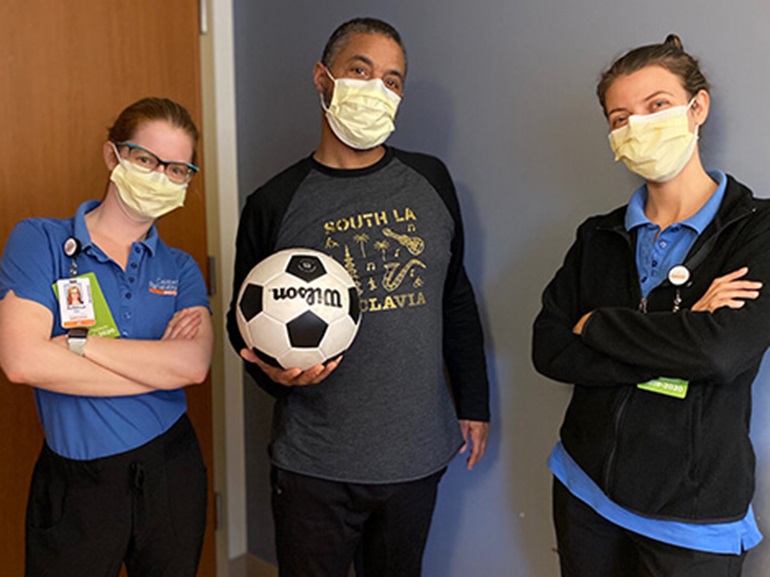Rod’s Story

Rod Edwards did the right thing at the onset of a cold and cough in mid-March. The 52-year-old radio advertising representative self-isolated, hoping it would pass. Other than being diagnosed with diabetes in 2000, Rod was healthy. But as the week passed, he felt worse. He was driven to Cedars-Sinai Hospital and tested positive for COVID-19 and was admitted. He was placed in isolation March 21 and four days later placed on a ventilator to help him breathe.
Rod’s next memory was waking up in the intensive care unit after being removed from the ventilator. His lungs were healing, but even small amounts of physical activity still left him struggling to breathe. He was weak too, noting his legs “felt like Jell-O.” However, Rod was motivated to start rehabilitation. His Cedars-Sinai care team recommended California Rehabilitation Institute, where he transferred April 13.
Rod arrived ready to improve his overall condition which included impaired balance, low endurance, general weakness and tight joints. His goal was return to his pre-COVID life and the primary motivator was to play soccer with his daughter again.
Long-term immobility can make joints particularly stiff – that was true of Rod’s ankles. Therapists focused their efforts on stretching to loosen his joints and hip flexor muscles. The latter would ease his back aches. Yoga also brought added relief for his stiffness and pain.
COVID-19 impacts the respiratory system and with the uptick in his activities, Rod’s team worked with him on breathing techniques and exercises to improve his lung function.
Given the significant role of soccer in his life, Rod’s therapists wove elements of the sport into his treatment. They trained him on balance and coordination with short stints of soccer. He also sat on an exercise ball for more balance work and to build core strength. In addition, Rod regularly bounced the soccer ball on his knee and dribbled it down the hallways.
The therapy team fortified Rod’s balance work with a pebble step. The step is a small, plastic triangle with uneven edges that is placed on the ground. Rod would step on the uneven surface which helped improve his balance. Therapists also employed an agility ladder to improve Rod’s gait and foot placement. The ladder-like tool was laid on the floor and Rod was coached to step through it in multiple directions.
Rod said his goal was to push himself during therapy. His advice to others going through a similar journey is to have faith and focus on the future. "You, too will prevail,” said Rod. “Look for the light at the end of the tunnel because there is one."
Recovering from COVID-19 can be a mental challenge too, especially so when hospitals have to implement pandemic induced no visitor policies. But Rod’s morale was boosted daily by the video chats the hospital arranged with his daughter and other family members. It always brought a smile to his face.
On April 23, Rod was thrilled to return home to his family and relished playing soccer again with his daughter. He also said he was looking forward to enjoying one of the simpler pleasures in life, “laying on a super comfy couch with a fluffy blanket straight from the dryer.”
Rod plans to continue building his strength in outpatient therapy and ultimately would like to get back to enjoying the life he led prior to his ordeal. We wish him well.